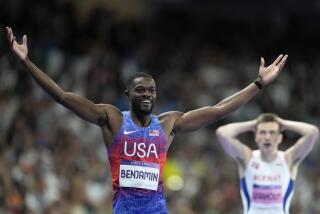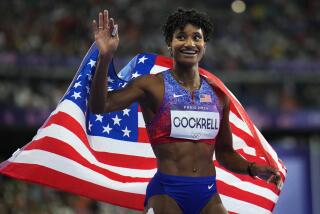U.S. OLYMPIC TRACK AND FIELD TRIALS : Griffith-Joyner Fails in Record Try : She Wins 200 in 21.85; Fosterâs Luck Runs Out
INDIANAPOLIS â Greg Foster, his left arm broken in two places, did not make it through the semifinals of the 110-meter hurdles. Florence Griffith-Joyner did not break the world record in the womenâs 200 meters. John Powell did not make his fifth Olympic team in the discus throw.
So why did so many people feel so good Saturday after the ninth and final day of the U.S. Olympic track and field trials at the Indiana-Purdue University Stadium?
It could be because they had witnessed one of the most memorable meets of all time, a meet in which Griffith-Joyner ran the womenâs 100 meters in 10.49 seconds to shatter the world record, Jackie Joyner-Kersee became the first woman to surpass 7,200 points in the heptathlon, two men ran faster than 44 seconds in the 400 meters for the first time in 20 years, and veterans such as Carl Lewis, Edwin Moses, Mary Decker Slaney, Mac Wilkins and Willie Banks proved that they still have their fastballs.
Fast. That is the best way to describe the U.S. track and field team that will begin competition Sept. 23 in the Olympic Games at Seoul.
The United States sent a team to the World Championships in Rome last year that won a disappointing 19 medals, 12 fewer than were won by the East Germans. Among the U.S. medalists, seven are not going to Seoul.
Yet, the U.S. head coaches, Stan Huntsman and Terry Crawford, both of the University of Texas, said Saturday that the United States is sending its best track and field team ever to the Olympics. Huntsman may get an argument from those who remember the 1968 menâs team that won 12 gold medals in Mexico City, but Crawford is safe in her comment that no U.S. womenâs team has ever had this much talent.
While almost everyone seemed a little giddy after the last event on a hot, but not-too-hot, Saturday, a day jammed with nine finals before a capacity crowd of 13,796, it was difficult to remember that the afternoon began on a sad note for one of the United Statesâ most decorated track and field athletes.
Less than three weeks after 14 screws and 5 plates were placed in his broken left arm, the result of a July 4 training accident, Fosterâs valiant attempt to make the Olympic team ended in the semifinals of the 110-meter hurdles.
Foster, a former UCLA athlete who lives in Chino Hills, survived the first two rounds Friday night, but wearing an even more extensive hand-to-elbow bandage Saturday, he clipped the fourth and fifth hurdles, almost knocked over the sixth and then crashed into the seventh before quitting the race.
âI got tangled up with (Keith Talley in) Lane 8 for a second,â he said. âThat threw me off a little bit, and I wasnât able to recover.
âI promised the doctor before I left Los Angeles that I wouldnât fall. If I started to go down, I was going to pull up. The doctor said that if I fell and broke the arm again, he didnât want to be the one to put it back together.â
As he left the track, Foster, a two-time world champion, received a standing ovation from the crowd. Later, after the final, the three hurdlers who made the team--Roger Kingdom (13.21 after a 1988-best-in-the world time of 13.14 in the semifinal), Tonie Campbell (13.25) and Arthur Blake (13.28)--also applauded Foster.
âMy hatâs off to Greg Foster, if I had a hat,â said Campbell, who lives in Ontario and has been a not-so-friendly rival of Fosterâs. âHeâs one of the most courageous men that Iâve ever seen. Heâs your front-page story. Weâre going to Seoul, but weâre carrying the torch for him.â
Of all the races Saturday, the most interesting were the two 1,500s.
In the menâs metric mile, Tim Simpson of Lyndonville, Vt., ran the first 800 meters as if he were trying to make the U.S. team in that event, finishing two laps 25 meters ahead of the rest of the field in 2:00.09.
Predictably, he wilted in the next 200 meters, going from first to next-to-last, as Jeff Atkinson of Manhattan Beach and two-time Olympian Steve Scott of Fallbrook took over the pace. They battled for the last 300 meters, Atkinson holding a half-step lead all the way to the finish line. He was timed in 3:40.94 to Scottâs 3:41.12.
It was surprising enough that Atkinson, 25, made the team, because his highest U.S. ranking ever was fifth in 1986. But the third-place finisher, Mark Deady, 20, of Prairieville, Ill. was a stunner.
He was second in the NCAA Championships for Indiana University this year, but the only college miler thought to have a chance in this field was NCAA champion Joe Falcon of Arkansas. He finished 11th, just ahead of Simpson.
In making the team, Deady, who was caught in the pack with 100 meters remaining, had to outsprint Jim Spivey of Glen Ellyn, Ill., third in the 1987 World Championships. Deady ran 3:41.12 to Spiveyâs 3:41.52.
As the alternate, Spivey may still go to Seoul because Deady has not met the Olympic qualifying time of 3:38.50. He has until September.
âNo disrespect for Mark or Jeff, but that would have been the last combination I would have ever come up with for the Olympic team,â said Scott, 32.
âI was aware that Jeff was coming on this year, but I didnât think he had that extra gear. He really made a major jump today. As for Mark Deady, he just came into his own this year, especially in this race. That was a pretty âstudlyâ finish he made in this race.â
No one would describe the finish by either Slaney or Regina Jacobs in the womenâs 1,500 in exactly those words, but they were both impressive.
As she often does, especially when running against other Americans, Slaney ran off with the pace, opening a 15-meter lead after two laps. Jacobs moved into second on the third lap, but she kept her distance from Slaney until the final 200 meters.
Entering the stretch, Jacobs was within a step of Slaney. It was reminiscent of the trials in 1984, when Ruth Wysocki of Canyon Lake ran down Slaney on the last lap of the 1,500.
This time, Slaney, even though she won the 3,000 the previous weekend, had something left. Her kick was too much for Jacobs as Slaney finished in 3:58.92, the third-fastest time ever by an American. Of course, she is the American who also has the two fastest times.
Jacobs, who lives in Culver City, finished second in 4:00.46 to become the third-fastest American performer in that event. Kim Gallagher of El Segundo, who earlier made the team by winning the 800 meters, was third in 4:05.41. Wysocki was fourth in 4:06.58.
âI just gave Regina Jacobs the hardest handshake sheâs ever felt,â said Crawford, the Olympic womenâs coach. âThe quality of her racing was terrific.â
Jacobs, 24, said she made a tactical error.
âI should have waited until the last 100 meters to make my move,â she said. âI went too soon. I didnât have complete confidence to carry it all the way. It takes a couple of races to develop that and beat runners like her. Next time, Iâll wait.â
While Slaney won, so did the two other brightest stars in U.S. womenâs track and field, Griffith-Joyner and Joyner-Kersee.
Griffith-Joyner of Van Nuys completed her 100-200 sweep, winning the latter Saturday in 21.85. It didnât approach the world record of 21.71, but it gave her four times this week under 22 seconds, including an American record of 21.77 in the second round Friday. Her semifinal time Saturday was 21.90.
One of her training partners at UCLAâs Drake Stadium, Pam Marshall of Long Beach, finished second in the 200 in 21.93, and Gwen Torrence of Georgia, who, like Griffith-Joyner, earlier made the team in the 100, finished third in 22.02. Only three Americans have ever run faster than Marshall.
Joyner-Kersee equaled her best effort ever in the long jump, 24 feet 5 1/2 inches, but it was aided by a wind of 2.6 meters per second, over the allowable of 2.0 for record consideration.
She gave the crowd a scare when she slumped to the ground after her third jump, but she explained later that she skinned her knee on the concrete at the front of the pit, and she took her last two jumps with two Band Aids over the injury.
Sheila Echols of Baton Rouge, La., who finished fourth in the 100 last Sunday, was second in the long jump at 22-7. Carol Lewis, Carlâs sister, and USCâs Yvette Bates also jumped 22-7, but Lewis made the team because her second-best jump of 22-5 3/4 was better than Batesâ second-best jump of 21-11. Lewisâ 22-7 came on the last of her six jumps.
Joyner-Kersee wasnât the only heptathete who came back strong Saturday. Trish King of Yorba Linda, who finished eighth in the heptathlon, was second in the high jump with a personal best of 6-5. Her previous best was the 6-2 3/4 she cleared in the heptathlon high jump competition nine days before. She had never jumped higher than 6-0 before this year.
Louise Ritter of Dallas won the high jump at 6-6, and Coleen Sommer of Chandler, Ariz. was third at 6-5.
Wilkins, 37, of San Jose made his fourth Olympic team with a discus throw of 216-6. But Powell, 41, also of San Jose, could do no better than his first throw of 202 and will have to wait for another four years if he is to become the first man to make five U.S. Olympic track and field teams.
More to Read
Go beyond the scoreboard
Get the latest on L.A.'s teams in the daily Sports Report newsletter.
You may occasionally receive promotional content from the Los Angeles Times.






